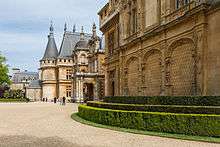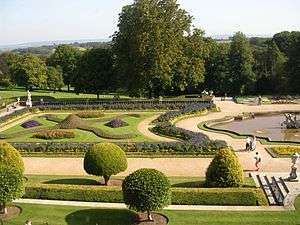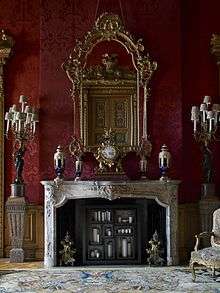Waddesdon Manor


Waddesdon Manor is a country house in the village of Waddesdon, in Buckinghamshire, England. It is located in the Aylesbury Vale, 6.6 miles (10.6 km) west of Aylesbury. The house was built in the Neo-Renaissance style of a French château between 1874 and 1889 for Baron Ferdinand de Rothschild (1839–1898) as a weekend residence for grand entertaining.
The last member of the Rothschild family to own Waddesdon was James de Rothschild (1878–1957). He bequeathed the house and its contents to the National Trust. It is now administered by a Rothschild charitable trust that is overseen by Jacob Rothschild, 4th Baron Rothschild. It is one of the National Trust's most visited properties, with around 335,000 visitors annually.[1]
Architecture

Prior to the construction of Waddesdon Manor, no house existed on the site. Ferdinand de Rothschild wanted a house in the style of the great Renaissance châteaux of the Loire Valley.[2] The Baron, a member of the Viennese branch of the Rothschild banking dynasty, chose as his architect Gabriel-Hippolyte Destailleur.[3] Destailleur was already experienced in working in this style, having overseen the restoration of many châteaux in that region, in particular that of the Château de Mouchy.
Through Destailleur's vision, Waddesdon embodied an eclectic style based on the châteaux so admired by his patron, Baron Ferdinand. The towers at Waddesdon were based on those of the Château de Maintenon, and the twin staircase towers, on the north facade, were inspired by the staircase tower at the Château de Chambord.[4] However, following the theme of unparalleled luxury at Waddesdon, the windows of the towers at Waddesdon were glazed, unlike those of the staircase at Chambord. They are also far more ornate.
The structural design of Waddesdon, however, was not all retrospective. Hidden from view were the most modern innovations of the late 19th century including a steel frame, which took the strain of walls on the upper floors, which consequently permitted the layout of these floors to differ completely from the lower floors.[5] The house also had hot and cold running water in its bathrooms, central heating, and an electric bell system to summon the numerous servants. The building contractor was Edward Conder & Son.[6]
Furnishings

Once his château was complete, Baron Ferdinand installed his extensive collections of French 18th-century boiseries, Savonnerie carpets, Gobelins and Beauvais tapestries, furniture, Sèvres ceramics, and books, as well as English and Dutch paintings and Renaissance treasures. Works were acquired for their exquisite quality and fine provenance. One of the highlights of the collection is the extraordinary musical automaton elephant, dating from 1774 and made by the French clockmaker H Martinet.[7] Of the ten surviving examples of the Sèvres pot-pourri vase in the shape of a ship from the 1760s, three are at Waddesdon, including one with a very rare scene of a battle connected to the Seven Years' War.[8]
In the 1890s, Baron Ferdinand focused on the Renaissance collection for his small museum in the New Smoking Room.[9] This collection was bequeathed to the British Museum and is now known as the Waddesdon Bequest.[10] The interior of Waddesdon Manor was photographed in 1897 for Baron Ferdinand's privately published The Red Book.[11]
Subsequent owners added noted collections of Limoges enamel, arms and armour, maiolica, medieval manuscripts, prints and drawings. Waddesdon’s internationally famous collection has thus been formed principally by four members of the Rothschild family: Baron Ferdinand de Rothschild (1839-1898), his sister Alice de Rothschild (1847-1922), their cousin Edmond James de Rothschild (1845-1934) and the present Lord Jacob Rothschild (b. 1936).[12]
Gardens

Extensive landscaping of the hill was carried out, including leveling the top. The gardens and landscape park were laid out by the French landscape architect Elie Lainé. An attempt was made to transplant full-grown trees by chloroforming their roots, to limit the shock. While this novel idea was unsuccessful, many very large trees were successfully transplanted. The gardens were enhanced with statuary, pavilions and an aviary that is still in use.[13] The Proserpina fountain was brought to the Manor at the end of the 19th century from the Palace of the Dukes of Parma in northern Italy: the Ducal Palace of Colorno. The gardens are listed Grade I on the Register of Historic Parks and Gardens.[14]
History
Baron Ferdinand played host to many important guests including the future Edward VII.[15] The grounds and house were such a wonder of their day that, in 1890, Queen Victoria invited herself to view them. The Queen was, however, more impressed by the electric lighting in the house than the wonders of the park. Fascinated by the invention she had not seen before, she is reported to have spent ten minutes switching a newly electrified 18th-century chandelier on and off.[16]
When Baron Ferdinand died in 1898, the house passed to his sister Alice de Rothschild, who further developed the collections.[17] Following Alice de Rothschild's death in 1922, the property and collections passed to her great-nephew James A. "Jimmy" de Rothschild of the French branch of the family, who further enriched it with objects from the collections of his late father Baron Edmond James de Rothschild of Paris.[18] James hosted a Liberal Party rally at Waddesdon in 1928, where David Lloyd George addressed the crowd.[19] During World War II, children under the age of five were evacuated from London and lived at Waddesdon Manor.
When James de Rothschild died in 1957, he bequeathed Waddesdon Manor, 200 acres (0.81 km2) of grounds and its contents to the National Trust, to be preserved for posterity. A nearby ancillary property, The Pavilion at Eythrope, became the home of James de Rothschild's widow, Dorothy de Rothschild, usually known as "Mrs James". She took a very keen interest in Waddesdon for the remainder of her long life. Eythrope and the rest of the Waddesdon estate were bequeathed to the 4th Lord Rothschild.
Jacob Rothschild, 4th Baron Rothschild, has been a major benefactor of Waddesdon Manor through the Alice Trust, a registered charity headed by the Rothschild family.[20] In an unprecedented arrangement, he was given authority by the National Trust in 1993 to run Waddesdon Manor as a semi-independent operation. Since 2011, the family charity handling Waddesdon’s management has been the Rothschild Foundation.[21][22]
The Manor underwent a major restoration from 1990 to 1997, and the visitor attractions were enhanced. In 2003, in a burglary committed by the Johnson Gang, approximately 100 priceless gold snuff boxes and other items were stolen from the collection prompting the installation of new security measures.[23] In 2012, it was announced that Waddesdon Manor would be one of the sites for Jubilee Woodlands, designated by the Woodland Trust to commemorate Queen Elizabeth II's Diamond Jubilee.[24]
Present day

New works of art continue to be acquired to complement the existing collections at Waddesdon, such as Le Faiseur de Châteaux de Cartes by Jean-Baptiste-Siméon Chardin, added in 2007. Contemporary works have also been sited near the Manor and on the wider estate including by Richard Long, Sarah Lucas and Angus Fairhurst.[25] Commissions to contemporary architects have also occurred. Windmill Hill Archive (2011) was designed by Stephen Marshall.[26] Flint House (2015) was designed by Skene Catling de la Peña.[27] It won RIBA House of the Year in 2015.[28] In April 2015, artist Joana Vasconcelos installed two sculptures entitled Lafite in front of the Manor.[29]
Since 2012, when Christie's chose the Manor to exhibit sculptures by leading contemporary artists,[30] the Manor has gone on to host other major exhibitions, including the Lod Mosaic.[31] Waddesdon was one venue celebrating the work of Henry Moore in 2015.[32] Bruce Munro has also exhibited several works at the Manor.[33]
In 2016, ceramic artist Kate Malone exhibited a collection of new work inspired by the gardens, collections and archive.[34] This followed an exhibition in 2012 by Edmund de Waal where his ceramic pieces were installed in the Manor.
Film and television
Multiple films have been shot at Waddesdon Manor, including the Carry On film Don't Lose Your Head (1966); Never Say Never Again (1983); An Ideal Husband (1999); the Indian film Kabhi Khushi Kabhie Gham... (2001); Ladies in Lavender (2004); The Queen (2006), in which interiors and the gardens doubled for Buckingham Palace; The Mummy: Tomb of the Dragon Emperor (2008); Sherlock Holmes: A Game of Shadows (2011); A Little Chaos (2014); Victor Frankenstein (2015), Our Kind of Traitor (2016); and The Infiltrator (2016).
Waddesdon Manor has been used in many television series.[35] These include Howards' Way (1985) as a chateau in France belonging to Charles Freere. The house more recently stood in for the exterior of the fictional Haxby Park in the second series of Downton Abbey (2011) (the interior was filmed at Halton House, another country home once owned by the Rothschilds). Estate roads featured in And Then There Were None (BBC One, 26–28 December 2015).
Notes
- ↑ National Trust Annual Report 2012/2013 Retrieved 28 September 2015.
- ↑ Girouard, p 22
- ↑ Girouard, p 23
- ↑ Girouard, p 24
- ↑ Girouard, p34
- ↑ Girouard, p 34
- ↑ A Marvellous Elephant Retrieved 28 September 2015
- ↑ Pot-pourri vase, 1761, Waddesdon Manor, acc. no. 2315 Retrieved 11 January 2016
- ↑ Katy Barrett (May 15, 2015). "In praise of the Waddesdon Bequest". Apollo. Retrieved 28 September 2015
- ↑ The Waddesdon Bequest A Rothschild Renaissance Retrieved 28 September 2015
- ↑ Waddesdon Manor, acc. no. 54 Retrieved 11 January 2016
- ↑ Art Collections at Waddesdon Manor Retrieved 21 June 2016
- ↑ The Aviary at Waddesdon Manor Retrieved 20 June 2016
- ↑ Historic England, "Waddesdon Manor (1000446)", National Heritage List for England, retrieved 9 February 2016
- ↑ The Rothschild Archive Retrieved 28 September 2015
- ↑ Girouard, p 48
- ↑ Girouard, p 50
- ↑ Girouard, p 55
- ↑ Selection of pamphlets & leaflets, (Liberal Publication Dept., 1928), p. 213; see also Waddesdon Manor, acc. no. 894, Retrieved 11 January 2016
- ↑ Charity Commission. "The Alice Trust", registered charity no. 290859. Retrieved 28 September 2015
- ↑ The Rothschild Foundation Retrieved 29 September 2015
- ↑ Charity Commission. THE ROTHSCHILD FOUNDATION, registered charity no. 1138145.
- ↑ Police arrest gang Retrieved 28 September 2015
- ↑ Queen's Jubilee wood at Waddeson Manor needs volunteers Retrieved 28 September 2015
- ↑ Rachel Spence (May 12, 2012). "Art, chez Rothschild". Financial Times.Retrieved 28 September 2015
- ↑ "Whistle down the windmill". World Architecture News. Retrieved 2015-09-29.
- ↑ Wainwright, Oliver. "Flint House". The Guardian. Retrieved 29 September 2015.
- ↑ "Flint House wins". Royal Institute of British Architects. November 25, 2015. Retrieved 4 January 2016
- ↑ Joana Vasconcelos in conversation with Jacob Rothschild about the Lafite sculpture at Waddesdon Retrieved 28 September 2015
- ↑ Christie's at Waddesdon Manor Retrieved 28 September 2015
- ↑ Cristina Odone (June 21, 2014). "Lord Rothschild interview". The Spectator. Retrieved 28 September 2015
- ↑ Exhibition review: Henry Moore at YSP, Waddesdon and Leeds Art Gallery Retrieved 28 September 2015
- ↑ Winter Light Retrieved 28 September 2015
- ↑ 'From the Manor drawn', "Ceramic Review", July/Aug 2016
- ↑ "IMDb, Waddesdon Manor Location". Retrieved 28 September 2015.
References
- Girouard, Mark A Hundred Years at Waddesdon, published by Rothschild Waddesdon, 1998, ISBN 0-9527809-2-5
Further reading
- Mrs James de Rothschild, Rothschilds at Waddesdon Manor (Collins, 1979) ISBN 0-00-216671-2
- Michael Hall and John Bigelow Taylor, Waddesdon Manor: The Heritage of a Rothschild House (Harry N. Abrams, Inc., 2002) ISBN 0-8109-0507-8
- Selma Schwartz, "The Waddesdon Companion Guide", 3rd revised ed., (The Alice Trust, Waddesdon Manor, 2008) ISBN
- Dora Thornton, A Rothschild Renaissance: The Waddesdon Bequest (British Museum Publications, 2015) ISBN 978-0714123455
External links
| Wikimedia Commons has media related to Waddesdon Manor. |
- Official website
- Waddesdon Manor YouTube channel
- Waddesdon Manor at the National Trust
- Historical Images of Waddesdon Manor House, Gardens and Aviary
- Waddesdon Manor entry from The DiCamillo Companion to British & Irish Country Houses
- Waddesdon Manor QuickTime Virtual Reality image of Waddesdon Manor's parterre
Coordinates: 51°50′32″N 0°56′16″W / 51.84222°N 0.93778°W